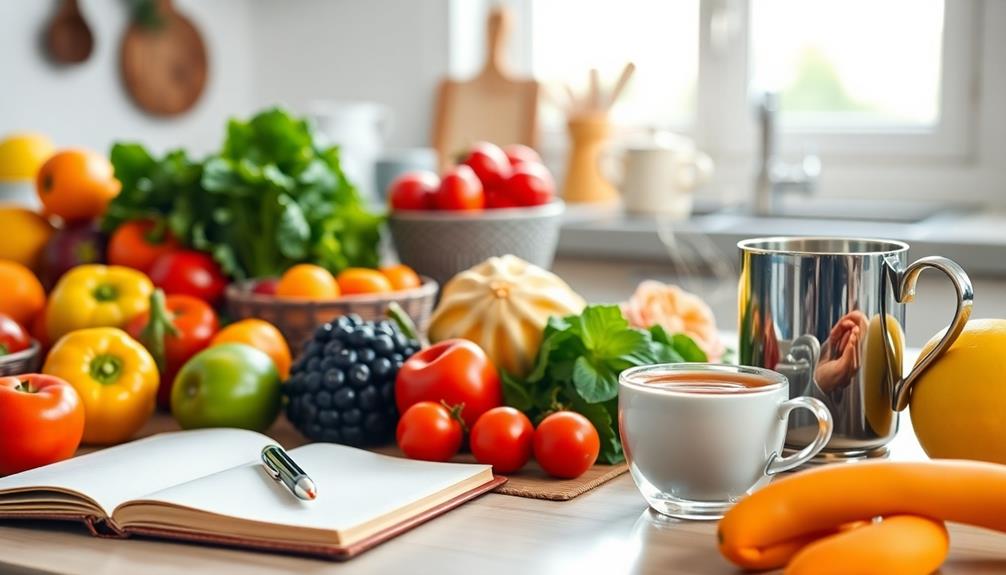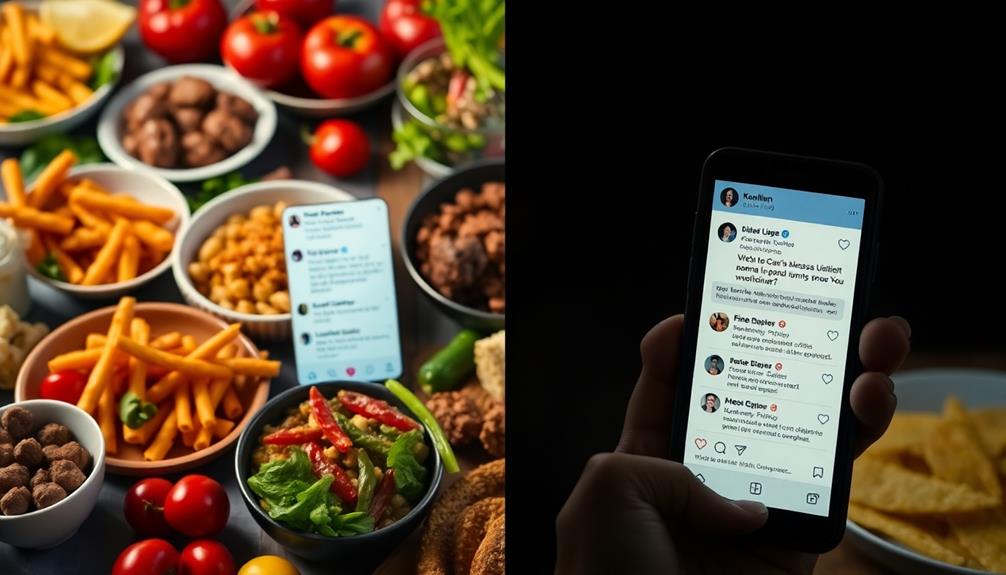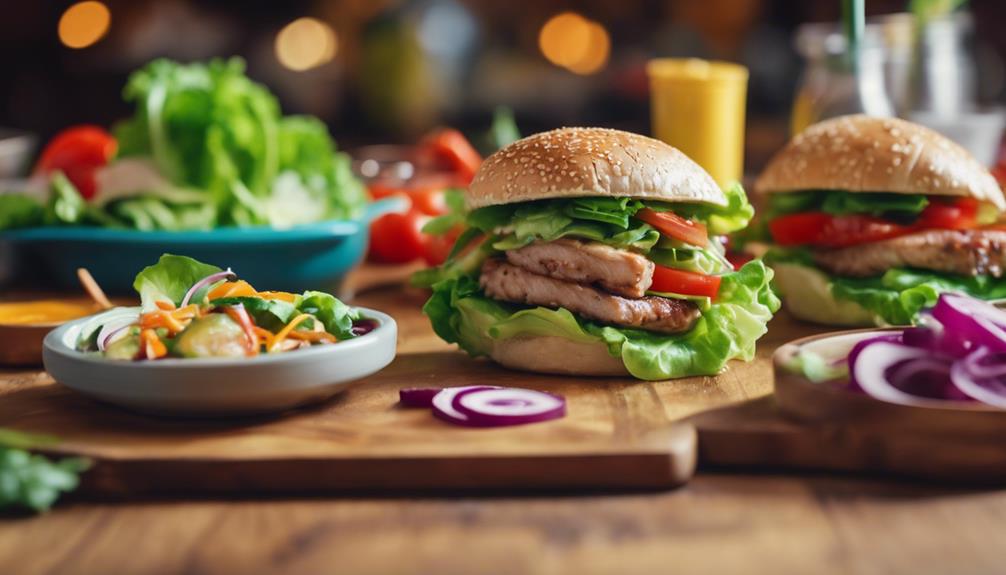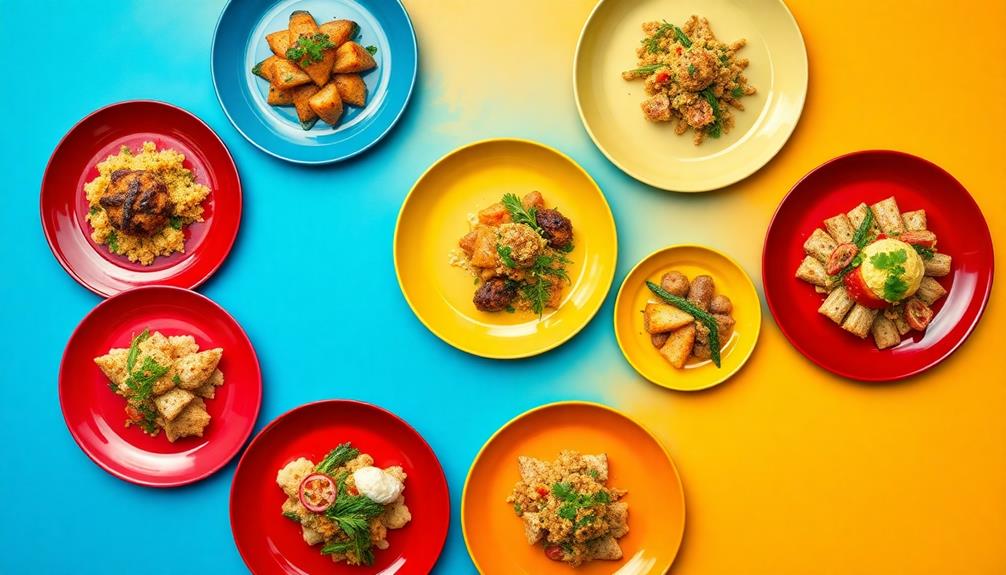Food guilt and shame can heavily impact your emotional well-being and self-image. When you indulge in foods labeled as “bad,” feelings of regret and anxiety often follow, fueled by diet culture and social media pressures. These negative emotions can create a vicious cycle, lowering your self-esteem and distorting your body image. Unplanned eating and strict dietary rules intensify these feelings, making it challenging to enjoy meals without judgment. By embracing self-compassion and redefining your relationship with food, you can break free from this cycle. Discovering new perspectives on food might just be your next step toward emotional freedom. By understanding the psychological effects of restrictive diets, you can begin to recognize how these patterns not only affect your mental health but also your overall relationship with food. Learning to approach meals with mindfulness and acceptance allows you to savor each bite without the accompanying guilt. Ultimately, fostering a healthier mindset can lead to a more balanced approach to nourishment, empowering you to reclaim joy in eating and cultivate a positive self-image.
Key Takeaways
- Food guilt arises from negative emotions like regret and shame, often linked to cultural beliefs categorizing foods as "good" or "bad."
- Emotional triggers, such as stress or social scrutiny, can intensify feelings of food guilt and lead to compulsive eating behaviors.
- Diet culture and social media perpetuate unrealistic body image standards, exacerbating feelings of inadequacy and fostering guilt around food choices.
- Mindful eating and self-compassion strategies can help individuals challenge ingrained beliefs, reducing food guilt and promoting a healthier relationship with food.
- Embracing body acceptance and individual differences helps counteract restrictive dieting, leading to lower guilt levels and improved emotional well-being.
Defining Food Guilt

Food guilt is a common experience many people face after indulging in foods they perceive as unhealthy or excessive. This feeling often stems from negative emotions like regret, shame, and fear, leading you to engage in harsh self-criticism.
Cultural beliefs play a significant role in shaping your perception of food, categorizing items as "good" or "bad." For instance, enjoying a slice of pumpkin roll during the holidays may evoke feelings of guilt, even though it's a traditional dessert meant for celebration. When you view eating certain foods as a moral failing, the guilt can intensify, making you feel like you've let yourself down.
This emotional turmoil doesn't just affect your mental state; it can also impact your eating habits. Research shows that persistent food guilt can exacerbate existing mental health issues such as anxiety and depression.
In your quest to cope with these feelings, you might develop disordered eating patterns, like binge eating or restrictive dieting, which only reinforce a negative cycle.
Understanding food guilt is essential for your overall well-being. By recognizing its roots in cultural beliefs and negative emotions, you can start to challenge these thoughts and foster a healthier relationship with food, free from the burden of guilt.
Emotional Effects of Guilt

Guilt can weigh heavily on your emotions, creating a cycle that's hard to break. When you experience guilt related to food, it often leads to negative emotions like anxiety and depression. These feelings can trigger emotional eating, where you reach for food not out of hunger but to cope with the shame and guilt you feel about your choices.
For instance, indulging in a rich dish like Red-Braised Pork Belly may lead to feelings of guilt for enjoying something deemed "unhealthy." This response can further deteriorate your mental health, causing you to spiral into restrictive dieting and excessive exercise in a desperate attempt to regain control.
Persistent guilt can undermine your self-esteem, leaving you with a distorted body image. You might find yourself obsessing over every meal, thinking that failure to stick to a diet means you're unworthy or weak. This thought process only intensifies feelings of shame and guilt, making it harder to break free from the cycle.
To address these emotional effects, it's crucial to recognize the primary emotions underlying your guilt. Often, guilt masks deeper feelings that deserve your attention. By understanding these complexities, you can begin to heal your relationship with food and improve your overall emotional well-being.
Common Triggers of Food Guilt

Many people find themselves grappling with food guilt in various situations. Unplanned eating occasions, like indulging in late-night snacks or consuming what you perceive as unhealthy foods, often spark feelings of regret and shame.
For instance, enjoying a classic Southern dish like squash casserole may leave some feeling guilty if they perceive it as indulgent. In social settings, where you might feel scrutinized or compared to others, this guilt can intensify, making you question your choices.
Strict dietary rules and black-and-white thinking about food can also play a significant role; when you label foods as "good" or "bad," eating something deemed "bad" can trigger profound guilt.
Emotional triggers, such as stress, anxiety, or sadness, often lead to cravings for comfort foods, followed by guilt and self-blame when you indulge. These moments can create a vicious cycle, where the relief of eating is overshadowed by the shame that follows.
Additionally, societal expectations around body image and health contribute to this environment, normalizing food guilt and making you feel inadequate about your eating habits.
Recognizing these common triggers can be the first step toward overcoming the guilt that often clouds your relationship with food.
The Role of Diet Culture

Diet culture has a powerful influence on how we perceive our food choices and, consequently, ourselves. It promotes the idea that certain foods are "bad" and that consuming them makes you morally inferior. This perspective leads to shame and guilt, especially when you break strict dieting rules.
For instance, enjoying a traditional dish like Caldeirada might trigger feelings of guilt, as it could be labeled as indulgent or unhealthy. You might find yourself trapped in black-and-white thinking, where foods are categorized as either "good" or "bad," heightening your food guilt when you indulge.
Furthermore, the anti-fat bias prevalent in diet culture creates unrealistic expectations about body image, causing you to feel guilty for not fitting into those narrow ideals. As you scroll through social media, you might encounter idealized body types and the obsession with "clean" eating, which only exacerbates feelings of inadequacy.
This environment can lead to food anxiety, making it difficult for you to enjoy meals without worrying about how they'll impact your body.
Ultimately, diet culture feeds into a cycle of shame and guilt around food, making it hard to develop a healthy relationship with what you eat. Breaking free from these constraints is essential for cultivating self-acceptance and enjoying food without anxiety.
Consequences of Food Guilt

The negative emotions stemming from food guilt can considerably disrupt your emotional well-being. When you feel guilty about what you eat, it often leads to feelings of shame, anxiety, and even depression.
For instance, you might find comfort in indulging in dishes like Mushroom Masala, only to feel guilty afterward if you perceive it as unhealthy. These negative emotions can push you towards compensatory behaviors, like restrictive dieting or excessive exercise, which can further exacerbate your struggles.
Persistent food guilt is linked to lower self-esteem and body image issues, frequently resulting in disordered eating patterns such as binge eating or emotional eating.
Cultural influences and societal pressures regarding food choices can intensify these feelings of guilt, fostering a collective food anxiety that worsens the situation. You might find yourself reaching for comfort foods, only to spiral into guilt afterward, creating a damaging cycle that makes it hard to develop a healthy relationship with food.
Instead of enjoying meals, you may obsess over what's "good" or "bad," ultimately leading to unhealthy eating habits, especially during stressful times. Recognizing these consequences is vital; understanding how food guilt affects you can be the first step toward breaking free from this cycle.
Strategies to Combat Guilt

To combat food guilt, start by challenging your beliefs about what you should or shouldn't eat.
For instance, embracing seasonal ingredients like those used in a Nettle and Potato Soup can help you appreciate the natural flavors of whole foods.
Practicing self-compassion can help you embrace your choices without judgment, while mindful eating techniques allow you to truly connect with your body's needs.
Challenge Food Beliefs
Many people struggle with ingrained food beliefs that can lead to guilt and shame after eating. To combat this, it's crucial to challenge food beliefs and question the origins of your food rules. Start by documenting your beliefs and their emotional impact. This practice can help you see how these beliefs contribute to feelings of guilt and reinforce negative consequences in your life.
For instance, indulging in traditional treats like Kue Putu can evoke feelings of guilt, but it's important to appreciate their cultural significance and enjoy them without judgment.
Embracing intuitive eating allows you to listen to your body's hunger and fullness cues, fostering a healthier relationship with food. Remember, all foods can fit into a balanced diet without moral implications. Instead of categorizing foods as strictly "good" or "bad," recognize that variety is key to nourishment and satisfaction.
Engage in positive self-talk as you navigate your food choices. When you focus on self-compassion, you cultivate a more forgiving mindset towards eating. By dismantling harmful narratives and replacing them with acceptance, you can reduce feelings of guilt and shame.
Ultimately, challenging your food beliefs is a powerful step towards reclaiming joy in eating and enhancing your overall well-being.
Practice Self-Compassion
Cultivating self-compassion is vital for transforming how you relate to food and your eating choices. When you replace negative self-talk with positive affirmations, you can appreciably improve your diet quality and reduce food guilt. For instance, enjoying traditional treats like Dorayaki (Red Bean Pancake) in moderation can foster a healthier mindset around indulgence.
Remember, everyone makes food choices they later question; nurturing a forgiving attitude towards yourself is essential.
Incorporating mindfulness exercises into your routine can enhance self-compassion. By focusing on the sensory experience of eating, you can appreciate your food choices without judgment, effectively lowering feelings of guilt.
Emotional reflection, such as journaling about your food experiences, helps you understand your relationship with food and fosters a more compassionate viewpoint towards your habits.
Additionally, seeking support from mental health professionals or dietitians who emphasize self-compassion can provide you with valuable tools and strategies. These resources can empower you to overcome pervasive food guilt and cultivate a healthier relationship with food.
Embracing self-compassion isn't just about feeling better; it's about forming a positive connection with your eating choices, leading to a more balanced and fulfilling life.
Mindful Eating Techniques
Mindful eating techniques can greatly alleviate food guilt by encouraging you to engage fully with your meals. By focusing on the experience of eating, you can foster a deeper connection with your body's hunger and satiety cues.
For instance, enjoying a Loaded Baked Potato can be a delightful way to practice mindful eating, as you savor the buttery goodness and rich toppings. This shift helps lower anxiety around food choices and reduces feelings of guilt after eating.
Here are three effective mindful eating techniques you can practice:
- Slow Down: Take your time during meals. Chew thoroughly and savor each bite. This allows you to recognize when you're satisfied, reducing the urge to overeat.
- Remove Distractions: Turn off screens and put away your phone. By being present, you can fully appreciate the flavors and textures of your food, enhancing your overall experience.
- Reflective Practices: After eating, consider journaling about your feelings and thoughts. This helps improve self-awareness and can identify triggers for emotional eating or guilt, guiding you towards healthier choices.
Incorporating these mindful eating strategies into your daily routine can help you align your eating habits with your health goals, ultimately promoting a more compassionate relationship with food.
Importance of Body Acceptance

Body acceptance plays an essential role in redefining your body image and embracing the unique aspects of yourself.
By cultivating self-compassion, you can shift your focus from restrictive dieting to a more intuitive and fulfilling relationship with food.
Incorporating diverse and nourishing foods, such as the high-fiber Yekolo (Roasted Barley), can enhance this relationship.
This shift not only eases food guilt but also fosters a healthier mindset around eating.
Redefining Body Image
Many people struggle with negative body image due to societal pressures and unrealistic beauty standards. Redefining your body image through body acceptance can help reduce food guilt and promote emotional well-being. By embracing your body as it is, you shift focus from restrictive diets to intuitive eating.
Here are three important ways to cultivate body acceptance:
- Practice self-love: Affirmations regarding your body can counteract negative self-perceptions. Regularly remind yourself of your worth beyond appearance.
- Challenge diet culture: Recognize that societal beauty standards are often unattainable. Rejecting these ideals allows you to appreciate your unique body.
- Prioritize your needs: Listen to your body and nourish it according to its signals. This approach fosters a healthier relationship with food.
As you work on body acceptance, remember it's a journey that takes time. However, the consistent efforts you make can lead to improved self-esteem and a positive self-image.
Ultimately, redefining your body image empowers you to cultivate a healthier mindset around food, freeing you from the guilt and shame often tied to your choices.
Embracing Individual Differences
Embracing the uniqueness of individual bodies is essential for fostering a healthier relationship with food. When you practice body acceptance, you respect your body's needs instead of adhering to restrictive diets that often lead to food guilt and shame.
Research shows that individuals who embrace their body's individual differences experience lower levels of guilt and shame related to eating, which promotes a more positive mental health outlook.
By recognizing that health comes in various shapes and sizes, you can counteract societal pressures that equate thinness with worthiness. Affirmations focused on body positivity can greatly aid your journey toward acceptance, enhancing your self-esteem and diminishing body-related worries.
Cultivating body acceptance takes time and consistent effort, but it's a crucial step in improving your mental health. As you learn to embrace your body, you'll find that it becomes easier to develop a healthy relationship with food, reducing the negative emotional impacts that often accompany feelings of food guilt.
Cultivating Self-Compassion Practices
Self-compassion is a powerful tool in cultivating a healthier relationship with food and body acceptance. By practicing self-compassion, you can reduce food guilt and embrace your body as it is.
Here are three ways to cultivate self-compassion and promote body acceptance:
- Engage in Body Image Affirmations: Regularly remind yourself of your body's worth beyond appearance. This helps alleviate worries about body image and fosters self-acceptance.
- Challenge Black-and-White Thinking: Dismantle the unspoken food rules that create feelings of guilt. Instead of viewing food choices as "good" or "bad," aim for balance and moderation in your eating habits.
- Embrace Body Diversity: Acknowledge that all bodies are unique and deserving of respect. Celebrating body diversity can diminish the shame associated with food choices and help you appreciate your own body more fully.
The Impact of Social Media

Social media plays a significant role in shaping how we perceive our bodies and food choices. When you scroll through curated images of "fit" bodies and "clean" eating, it's easy to feel a sense of inadequacy or shame about your own eating habits.
The promotion of unrealistic body ideals can lead to increased food guilt, especially when influencers endorse diet culture and label certain foods as "bad." This creates a stigma around eating, making you feel like you're morally wrong for enjoying pizza or dessert.
Research shows that regularly engaging with health and fitness content can heighten feelings of food-related guilt and even contribute to disordered eating behaviors.
The normalization of food guilt in online communities can spiral into negative self-talk, which exacerbates mental health issues and damages your relationship with food. Rather than fostering healthy eating habits, social media can inadvertently push you towards feelings of shame and anxiety around food choices.
Recognizing this impact can be the first step toward reclaiming your relationship with food and nurturing a healthier mindset.
Breaking the Guilt Cycle

Breaking the guilt cycle is essential for creating a healthier relationship with food. To do this, you need to shift your perspective on food choices from moral judgments to a more balanced viewpoint. Here are three strategies to help you break the guilt cycle:
- Practice Intuitive Eating: Tune into your body's hunger and fullness signals. This helps you enjoy food without the guilt that often accompanies certain choices.
- Engage in Mindfulness: Regularly practice mindfulness to reduce ruminating on food decisions. By staying present, you can alleviate feelings of guilt and foster a healthier mindset around eating.
- Cultivate Self-Compassion: Use gentle self-talk to counter negative thought patterns. Treat yourself kindly when you perceive dietary missteps, reinforcing a more positive relationship with food.
Incorporating these practices can greatly reduce guilt associated with food choices.
Promoting a Positive Relationship With Food

Embracing a positive relationship with food means shifting your mindset to see all foods as part of a spectrum rather than labeling them as "good" or "bad." This perspective can help you eliminate feelings of guilt and shame that often accompany food choices.
Cultivating this mindset involves practicing intuitive eating, where you listen to your hunger and fullness cues. By doing so, you can foster a healthier attitude toward food and reduce guilt-driven behaviors.
Mindful eating plays an essential role too; savoring each bite and being present during meals enhances your enjoyment and satisfaction. This practice can greatly decrease the likelihood of experiencing food guilt.
Additionally, incorporating self-compassion and positive self-talk about your food choices can transform your dietary experiences, leading to improved emotional well-being.
Building community connections around meals can further support your journey. Sharing food with loved ones promotes a sense of belonging, which can help reduce feelings of isolation that often contribute to food guilt and shame.
Frequently Asked Questions
What Is the Psychology of Food Shaming?
Food shaming stems from societal pressures and personal beliefs, making you feel judged for your choices. It can create negative emotions and compel you to restrict or binge eat, impacting your relationship with food.
What Is the Root of Guilt and Shame?
You might've felt guilt or shame when you didn't meet expectations. These emotions often arise from internalized beliefs, societal pressures, or past experiences, influencing how you perceive yourself and your actions in various situations.
Why Do I Feel Guilty After Eating Junk Food?
You feel guilty after eating junk food because you've internalized societal messages that label certain foods as "bad." This pressure can distort your self-image, leading to regret and anxiety about your food choices.
What Are the Psychological Effects of Guilt and Shame?
Guilt and shame can weigh heavily on you, leading to anxiety, lowered self-esteem, and negative self-perception. These emotions often create a cycle of distress, affecting your mental well-being and influencing your decision-making in various areas.
Conclusion
As you step away from the weight of food guilt, imagine a vibrant garden where every meal blooms with color and flavor, free from shame. Embracing body acceptance allows you to savor each bite, nourishing not just your body but your spirit. Let the sun of self-love shine through the clouds of diet culture, illuminating a path toward a joyful relationship with food. You deserve to feast without fear, celebrating every delicious moment life has to offer.










